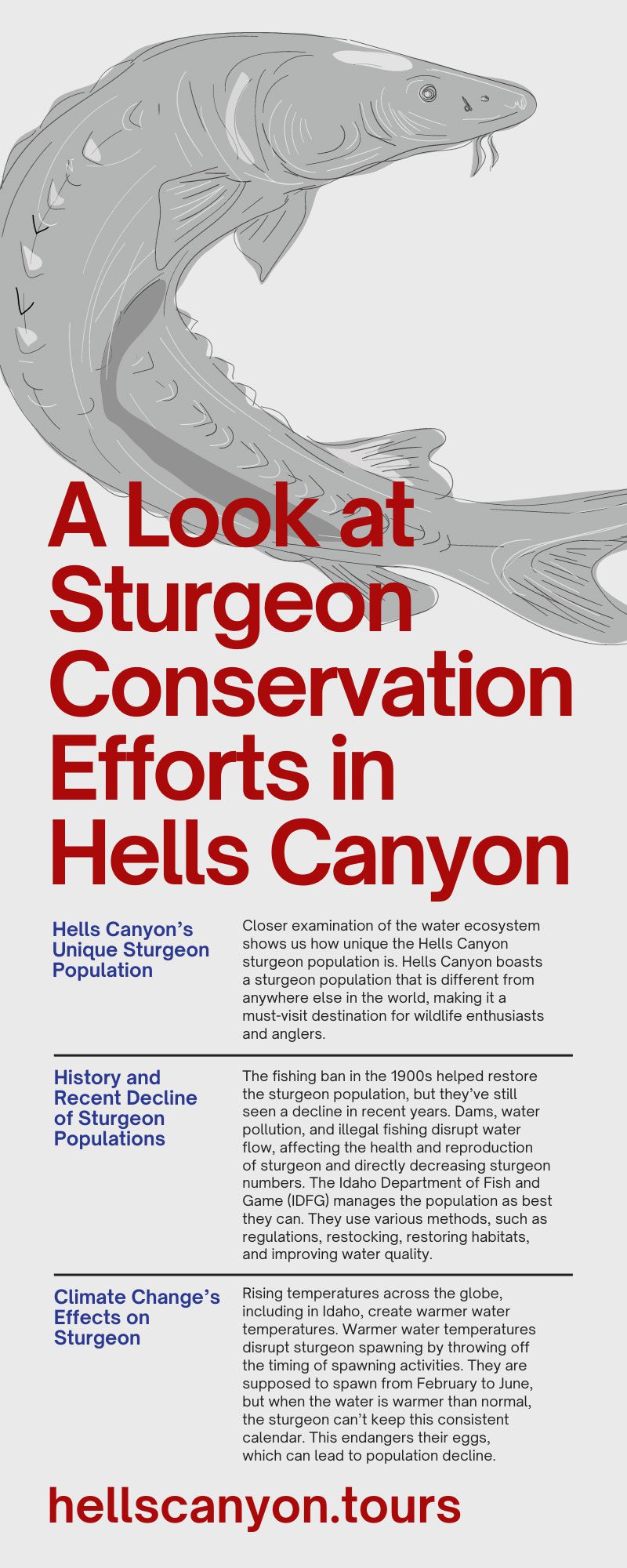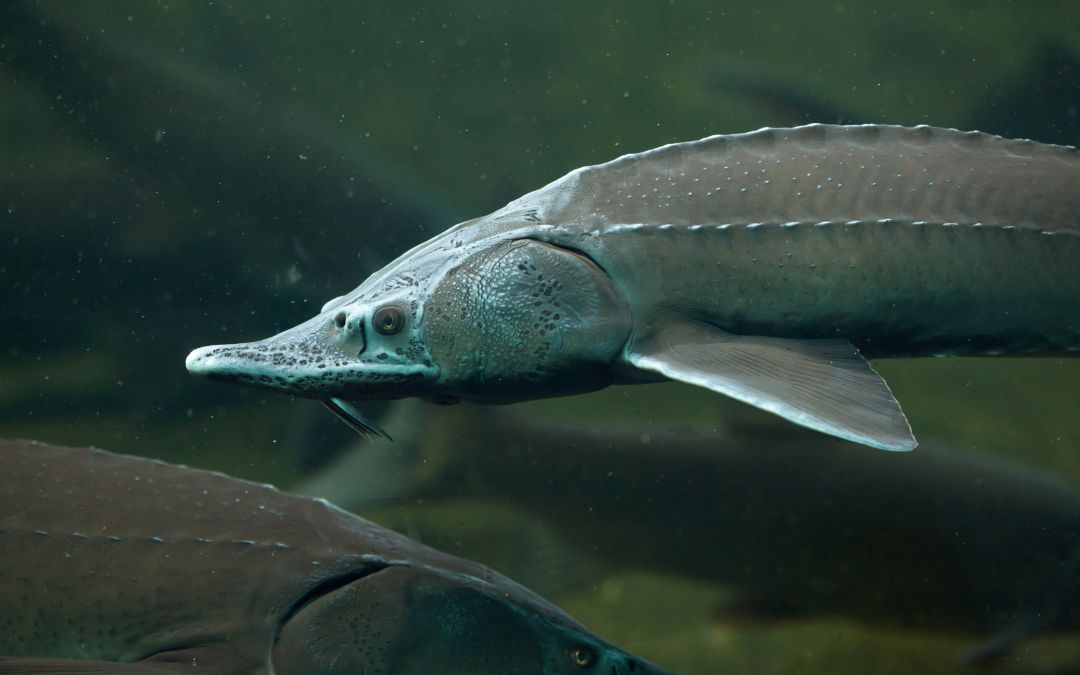Many areas across the US are home to incredible ecosystems with diverse wildlife that you can explore. Wildlife enthusiasts and anglers especially enjoy areas with rich water ecosystems, such as the Snake River in Hells Canyon. Some of the wildlife that makes this area so unique is the sturgeon population. Unfortunately, that unique population is in decline. Keep reading to take a quick look at sturgeon conservation efforts in Hells Canyon to better understand this issue, especially if you’re an angler planning to visit.
Introduction to the Hells Canyon Ecosystem
Hells Canyon is a remarkable wonderland on the Idaho-Oregon border, boasting a diverse ecosystem on land and within its waters. From breathtaking landscapes to abundant wildlife, it is truly a nature lover’s paradise.
Land
The land ecosystem features rugged mountains and valleys, as you would expect from a river gorge. The diverse terrain provides habitats for a wide range of species, creating a thriving ecosystem for wildlife like elk and native plants.
Water
The water ecosystem is highlighted by the Snake River, which has carved the incredible gorge. The Snake River is home to indigenous fish species like white sturgeon. Waterfalls like Wildcat Falls add to the region’s beauty and bring the land and water ecosystems closer together.
Hells Canyon’s Unique Sturgeon Population
Closer examination of the water ecosystem shows us how unique the Hells Canyon sturgeon population is. Hells Canyon boasts a sturgeon population that is different from anywhere else in the world, making it a must-visit destination for wildlife enthusiasts and anglers.
The Sturgeon
The sturgeon population is unique in several ways. First, they can grow up to 10 feet long and weigh hundreds of pounds, making them exciting to spot and a challenge to catch. Second, they coexist with other predators like bass and catfish, developing exceptional resistance and hunting skills that make them even more unique.
Their Habitat
The sturgeon themselves aren’t the only unique thing wildlife enthusiasts and anglers will notice. Their habitat at the confluence of the Snake River and Salmon River is uniquely ideal since they thrive in cold, deep waters. The primary species is the white sturgeon, which is the longest-living freshwater fish in North America. They need the cold, deep freshwater to survive, with some living to be 100 years old.
History and Recent Decline of Sturgeon Populations
With such a unique habitat and incredible lifespan, sturgeon draw many wildlife enthusiasts and anglers to Hells Canyon each year. Unfortunately, historical and recent problems have caused a decline in the population.
History of Hells Canyon Sturgeon
The sturgeon population in Idaho’s Hells Canyon dates back millions of years, making it one of the oldest fish species. Overfishing in the early 1900s led to a decline in sturgeon, but the population recovered after a fishing ban.
Recent Population Decline
The fishing ban in the 1900s helped restore the sturgeon population, but they’ve still seen a decline in recent years. Dams, water pollution, and illegal fishing disrupt water flow, affecting the health and reproduction of sturgeon and directly decreasing sturgeon numbers. The Idaho Department of Fish and Game (IDFG) manages the population as best they can. They use various methods, such as regulations, restocking, restoring habitats, and improving water quality.
Climate Change’s Effects on Sturgeon
The recent decline in Hells Canyon’s sturgeon population also stems from climate change. Rising temperatures, decreasing water levels, and disrupted food chains pose a great threat to this already declining population.
Warmer Water Temperatures
Rising temperatures across the globe, including in Idaho, create warmer water temperatures. Warmer water temperatures disrupt sturgeon spawning by throwing off the timing of spawning activities. They are supposed to spawn from February to June, but when the water is warmer than normal, the sturgeon can’t keep this consistent calendar. This endangers their eggs, which can lead to population decline.
Less Food Available
The warmer temperatures also disrupt the breeding habits of sturgeon’s prey, such as fish that migrate into Hells Canyon from the ocean. With less prey to catch, sturgeons must hunt for alternative food sources or starve, which happens all too frequently.
Importance of Sturgeon Conservation
With so many problems facing the sturgeon population of Hells Canyon, conservation efforts are more important than ever. Sturgeon conservation is about more than saving a unique fish, though.
Sturgeon’s Role in the Ecosystem
Sturgeon plays a crucial role in maintaining the balance of Hells Canyon’s ecosystem. They are top predators that consume smaller fish, which prevents overgrazing and the decline of other species. Conserving the sturgeon population is vital for the preservation of the entire water ecosystem.
Impact on the Local Economy
Fishing for white sturgeon in Hells Canyon is a popular activity that contributes to the local economy. River Adventures knows about this firsthand, which is why we offer fishing trips. Conservation efforts ensure a healthy sturgeon population, sustaining angling opportunities and promoting tourism in the area.
Collaborative Efforts To Protect Sturgeon
Many people, organizations, and companies are making a collaborative effort to protect sturgeon since they are so important to the ecosystem and economy. Local indigenous tribes are some of the biggest collaborators in these efforts.
Radio Transmitters With the Shoshone-Bannock
The first collaborative effort to protect sturgeons in Hells Canyon involves the use of radio transmitters attached to the sturgeon. Since 2010, the Shoshone-Bannock Tribes have collaborated with Idaho Power Company and the Idaho Department of Fish and Game to study sturgeon using these transmitters. They’ve discovered that sturgeon use different areas of the Snake River for feeding, migration, and spawning. Tracking the fish with radio transmitters allows them to better protect the sturgeon and help restore the population.
Habitat Restoration With the Nez Perce
The Nez Perce Tribe, in conjunction with Idaho Power Company, is working to restore critical spawning habitat for sturgeon in the Snake River. This includes removing invasive plant species and planting native vegetation to improve water quality and provide cover for juvenile sturgeon. They’re also working to create better access for sturgeon to migrate and spawn in key areas while discouraging illegal fishing.
Conservation Support Options for Recreational Anglers
While it’s great that local tribes and companies are collaborating to conserve sturgeon, many recreational anglers wonder how they can help. If you want to continue to enjoy fishing while caring for this unique fish population, you have several support options.
Hire a Conservation Conscious Guide
Many people hire guides when they go fishing in Hells Canyon. If you decide to hire a guide, make sure to ask if they are conservation-conscious. Guides who care about conservation efforts are more likely to put in place catch-and-release practices and encourage responsible fishing practices. When you follow their example, you can enjoy your fishing experience and know you haven’t contributed to sturgeon depopulation.
Donate to Local Conservation Efforts
If you’re only fishing in Hells Canyon for a short amount of time, you may not have many opportunities to support local conservation efforts. Even if you hire a conservation-conscious guide, you may want to do more. Financially donating to local conservation efforts can go a long way toward helping the sturgeon population, and you can do so at any time before, during, or after your trip.
River Adventures practices conservation-conscious habits on our Hells Canyon fishing trips because we understand the importance of sturgeon conservation in Hells Canyon. We look forward to welcoming you on one of these trips and showing you our unique sturgeon population and their incredible ecosystem.


Recent Comments